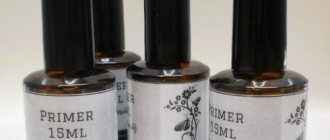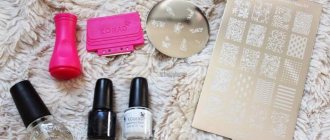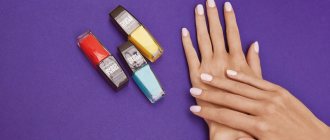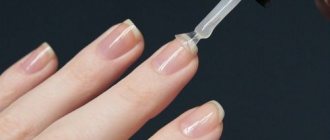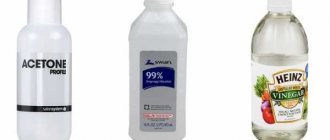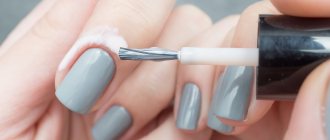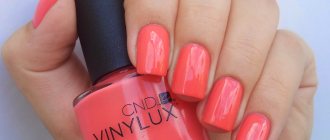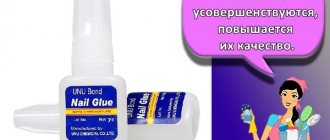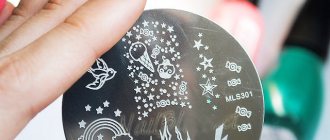Hello, dear readers! Do your nail polish often peel off? Do bubbles form on the surface when the varnish dries? Have you been dreaming of a beautiful and long-lasting manicure for so long? Don't worry, there is a way out! A nail dehydrator will help solve the problem. What it is, what it is used for and how to choose it correctly, you will learn from today’s article.
What is a dehydrator?
In order to create not only a beautiful, but also resistant to external influences manicure, you need to have a lot of necessary materials and tools. Any nail artist will have primers, bases, tops and other products that will make your nails beautiful and durable.
One of the most commonly used bottles on a manicurist's shelf is a dehydrator—a clear, colorless, slightly viscous liquid. Like most other manicure materials, it is applied to the nail with a brush and then dried. Dehydrators are usually used for preliminary preparation of the nail surface for the application of varnish or gel polish, acrylic coatings, and also before the extension procedure.
Using a dehydrator
To degrease and disinfect nails during the application of decorative coating, products containing dehydrators are used. They are produced in the form of separate preparations or included in disinfectants. The bottles are equipped with an applicator with a brush, which distributes the liquid over the plate in an even layer.
A dehydrator is an indispensable tool for those who have “wet hands.”
A quality product performs the following functions:
- cleanses nails of fatty traces and other contaminants;
- restores the natural balance of ph plates;
- disinfects the surface;
- promotes strong adhesion of varnish to the nail;
- prevents the development of pathogenic microflora;
- removes excess moisture.
Creating a manicure without using a dehydrator can result in rapid peeling of the decorative coating. This defect is observed already in the first week of wearing nail art.
The product has the form of a colorless liquid with a slight specific aroma. The consistency is slightly viscous, but fits well on the plate. You can buy a dehydrator at any store that has a manicure section.
The scope of application of the product is not limited to nail decoration. The product is also used for extensions.
Compound
The most important component in the dehydrator is an organic solvent - butyl acetate (ester of acetic acid). It is he who carefully removes excess from the surface of the nails without disturbing their internal structure.
In addition to it, the degreaser may contain the following substances:
- Dyes and flavors. In fact, they do not have any beneficial functions, but are found in many dehydrators. It is better to buy a degreaser without these components or with their minimum content. Why? These are generally not the most useful (and in this case, also unnecessary) elements. In addition, allergic reactions may occur to them.
- Acids (most often methacrylic). They improve the penetration of the product into the nail structure and have bonding properties. They are contained in safe quantities, but upon contact with skin they can still cause a fairly strong burning sensation. Therefore, you should work with an acid dehydrator very carefully!
- Resins. Included in acid-free primers. Promotes a soft, gentle effect on nails. They penetrate shallowly, and after drying they leave a thin sticky film on the surface.
What should be in a dehydrator?
Having found out why a nail dehydrator is needed and what it is in principle, you need to pay attention to its composition.
The following subtleties are important here:
- The basis of each dehydrator is butyl acetate (this is an ester of acetic acid with butyl properties), a solvent of organic origin. It is he who is able to remove moisture from the surface of the nail as delicately and accurately as possible, without damaging the nail or compromising the integrity of its structure. This substance evaporates almost instantly from the surface, without having time to affect the deeper keratin layers;
- The minimum amount of dyes and various fragrances in the product will be healthier for the plate;
- There are dehydrators containing acids that perfectly open the nail scales, penetrating into it. This function increases the subsequent adhesion of the plate and materials applied to it;
- acid-free bonders act more gently, sparing the plate without penetrating deep inside it.
When choosing a dehydrator in a store, you need to pay attention not only to its composition, but also to the cost. A good product cannot have a low price. Such products may not give the desired effect and may even cause harm to health by damaging the nail plate or causing an allergic reaction. A high price is also not a guarantee of purchasing a quality product.
It is better to prefer the middle price category, purchasing similar products only in trusted stores.
By using an acceptable amount of high-quality bonder, you don’t have to worry about your health in general or the safety of the nail plate in particular.
How to choose?
- When purchasing, first of all, pay attention to the composition - less unnecessary colors and flavors; acidic or acid-free.
- Do not be tempted by a suspiciously low price - as you know, a good product is never too cheap. On the other hand, high cost is also not always a guarantee of quality.
- The best option is to choose a product from a well-known brand, in a trusted store and at an average price.
Dehydrator and degreaser
Contrary to popular belief, they are not exactly the same thing. These products differ in both composition and purpose. The first penetrates deeper into the nail plate and dries it. And the second works more superficially, only removing dirt and excess fat from the nail.
Which is better to choose? Depends on skin type. If you have excessive sweating, it is better to use a dehydrator. And if the skin is normal or dry, a regular degreaser will be enough. Choose the tool that suits you best. You don’t need to use both at the same time—it won’t make your manicure any better.
Acid dehydrators
They contain methacrylic acid of varying concentrations (from 25%). Once applied, it evaporates quickly, leaving a light white residue. If it appears, then you can move on to the next stage.
After contact with acid, the nail surface will be able to reliably adhere to any foreign material. Therefore, it is very practical to use an acid primer when doing acrylic nail extensions.
Acid-free dehydrators
They do not contain acid and do not provide such a strong bond with the surface of the nail as acidic ones. Resins are used here as an adhesive material, creating a sticky layer.
“Acid-free” remove the greasy film, dry and sterilize the nail. They are recommended to be used before applying gel polish, as well as after a wet trim manicure - the likelihood of inflammation and infection with fungal diseases is reduced.
Attention! If you are going to do extensions with tips, you should not use an acid-free dehydrator - this may cause damage to the extensions. If you are correcting gel nails, apply it only to the regrown ends (without touching the skin!).
Is a nail dehydrator safe?
A nail dehydrator is a tool that allows you to prepare your nails for the application of synthetic varnishes and other substances. The issue of safety of its use is always relevant.
This liquid is in direct contact with the surface of the nails, but it does not penetrate inside , and, therefore, is not capable of having a toxic effect on its structure. In addition, the substance restores the acid-base balance, strengthens and gently cleanses the nails.
Using a high-quality dehydrator, you should not worry that the natural microflora of the nails may be disrupted or the epithelium of the horny part may be destroyed.
In general, bonder is a complex of gentle substances characterized by the following properties:
- lack of aggression towards the nail plate;
- normalization of the correct pH balance;
- gentle disinfection of the manicure area;
- increased strength of the applied coating;
- prevention of the occurrence of fungi and the development of infectious and bacterial processes.
Don't miss the most popular article in the section: How to draw monograms on nails step by step for beginners. Instructions with photos.
Dehydrator or primer: what's the difference?
Like other nail degreasers, primer is a base substance that is applied to the nail plate before applying gel polish. It has a liquid consistency, dries quickly on the nails, and makes the manicure last for a long time.
Many girls want to know whether a dehydrator and a primer are the same thing or not.
These are almost identical substances, but there are still at least three significant differences between them:
- The primer makes the surface of the nails rougher, and in general it is not as gentle on your nails as a regular dehydrator or degreaser.
- The primer better protects you from the chemicals contained in artificial coatings and prevents them from penetrating living tissue.
- When using a primer, the manicure lasts longer than when treated with a conventional dehydrator.
What is it and what are they for?
This is a transparent auxiliary liquid intended for treating the nail before applying any coating to it in order to achieve the longest possible preservation of the final result. As a rule, it is an odorless and colorless substance, which includes an organic solvent butyl acetate with vitamin and antiseptic additives that reduce the fragility of nails, strengthen them and prevent the process of delamination. Sometimes this product is called “bond” or “bonder”, which is essentially the same thing.
The release form is a bottle with a cap equipped with an applicator, similar to nail polish.
The functionality is aimed at solving the following tasks:
- degreasing;
- cleansing;
- drying and removing excess moisture;
- normalization of acid-base balance;
- eliminating the risk of fungal diseases and improving health;
- ensuring reliable adhesion of the nail to the coating;
- guarantee of strength and durability;
- preservation of the result for the longest possible time.
Sometimes the question arises about the safety of using this product. Negative consequences are possible only in case of individual intolerance to the components or improper use, for example, in case of contact with the skin. The dehydrator does not affect the color of the paint, does not destroy the nail plate and does not harm brittle and thin nails.
Do not underestimate the role of a dehydrator in the process of creating high-quality nail art - this is a mandatory step. Otherwise, there may be problems with the health of the nails, peeling of the coating, the appearance of bubbles on the surface due to moisture not removed in time, and a reduction in the durability of the manicure. All these negative consequences are especially intense when your hands get wet. Another caution concerns the use of nail polish remover for degreasing purposes instead of a specially formulated product. By drying and degreasing, the product negatively affects the surface of the nail - subsequently it becomes brittle, thin and very flaky. Rehabilitation treatment will be required. Nail polish remover is produced for a specific task - removing the coating. Nothing can handle the function of preparing for applying varnish better than a product specially designed for this purpose. Therefore, you should not skimp on it if you care about the health of your nails and the quality of your manicure.
Primer and bonder
The words “primer” and “bonder” are considered almost synonymous. But there are some differences between these means.
Bonder is used to enhance the bonding properties of acrylic, gel and other nail extension products. It also prevents the extensions from peeling off and maintains the acid-base (pH) balance of the nails. The bonder is applied after the primer and then dried under a lamp.
Read more about primer and bonder in one of the following articles
How can I replace nail degreaser?
Nail degreaser can be replaced:
- formic alcohol;
- ethanol with a strength of 70 degrees;
- acetone-containing nail polish remover, but without oils;
- vinegar;
- boric acid;
- special napkins.
Cologne and soap are used at home with less success. They dry nails and skin well, but leave particles on the surfaces that prevent reliable adhesion of the base to the plate.
What can you use at home?
At home, instead of degreasing liquid, you can use other drying and disinfectants. It is important that they do not harm the nails and skin. An alternative could be:
- Regular alcohol. You need a product with a strength of 70, or preferably 90 degrees. Vodka is not useful here, as it contains components that can interfere with adhesion. You can degrease your nails with alcohol, as it copes equally well with dust, grease and sweat, and is non-toxic. In addition, the product has excellent disinfectant properties. But it’s better not to use it too often, as there is a risk of drying out the nail plate too much. And not everyone likes the smell of the product.
- Ant alcohol for nails. Many manicurists call this product an ideal degreaser. It consists of formic acid and 70% alcohol, both components have drying and disinfecting properties. That is, the effectiveness of this liquid is higher than the previous substitute. You can buy it at a pharmacy without a prescription.
Formic alcohol is often used by nail artists for clients who are prone to allergies.
- Regular nail polish remover. It should not contain oils. But still, you can degrease your nails with nail polish remover only as an exception, if there is nothing else. After all, the main component of a product suitable for this is acetone. And with frequent use, it destroys the nail plate.
Some people use other products that can be found at home, but they cannot be called a worthy replacement for a degreaser:
- Cologne. Cheap perfume liquids produced since the times of the USSR have sufficient drying properties. For example, “Triple Cologne”. But they may also contain oils that will prevent reliable adhesion of the base to the nail plate. In addition, such a perfume has a pungent odor, and it will remain on your hands for a long time, despite thorough washing.
Modern colognes certainly cannot replace a degreaser, since they contain many moisturizing components.
- Vinegar. The product also has drying properties, washes away nail dust, fungus and many bacteria are afraid of it. But you can use vinegar instead of a degreaser once, and not on an ongoing basis, and only with strong nails. It contains several acids and alcohol, so if used frequently it can harm them. And the smell will take a long time to dissipate from your hands.
- Soap. This is the most useless remedy of all, capable of helping only in the case of nails on which the coating sticks “as if nailed down.” It removes fat, sweat, and removes sawdust, but it itself contains moisturizing components and oils. Soap is washed off with water, and this is also moisture.
Pharmacy products
A preparation for coating can also be found at the pharmacy:
- Boric acid for degreasing nails is used in powder form, but it should be mixed with alcohol, not water. The product has weak antibacterial and antifungicidal properties and dries out. Its disadvantages include the ability to cause allergies in some cases and accumulate in tissues.
- Boric alcohol can also be used to degrease nails if the coating adheres well to them. If you have problems, it will not work. The product consists of an acid combined with 70% alcohol, but also water and glycerin. Both of the latter components do not contribute to the adhesion of the material used for coating and the nail plate. And if your nails and hands are wet, it is better to replace boric alcohol with something else.
Napkins
To remove sawdust, grease and moisture, there are special wipes impregnated with a degreasing compound, most often isopropanol. They have a lot of advantages over all other options:
- cut into small, easy-to-use pieces;
- equally well remove excess from nails and stickiness from polymerized coating;
- do not leave lint on the surface, unlike cotton pads soaked in degreaser;
- Sold in large packages, one will last for a long time.
Typically, napkins do not cause allergies, and when used, as well as other high-quality materials, the coating wears well.
Replacing funds
Has this ever happened to you - you start doing a manicure, and the dehydrator suddenly runs out? And there is no new bottle either. Involuntarily, you have to look for something to replace the primer in such a situation. Of course, the “analogues” listed below will not replace this product, and using them on an ongoing basis is not at all recommended. So, even nail service specialists sometimes use the following instead of primers:
- boric alcohol 3%;
- acetone or nail polish remover based on it (if it contains oil, this will not work);
- medical alcohol;
- vinegar;
- cologne.
Using such substitutes, you greatly dehydrate the nail plate. And the result that is achieved with a real dehydrator cannot be expected here.
How to use it correctly
- You need to start by polishing the nail with a buff and removing the resulting dust from the surface.
Grinding should be treated with caution and this procedure should only be performed no more than once every six months.
- Since the active substances of the dehydrator evaporate instantly, it should be applied one by one to each finger immediately before forming the artificial coating.
The product should be applied with a brush in a thin layer to the nail from the cuticle to the free edge.
Making a durable coating
Nail experts say that it is not difficult to make a high-quality manicure using a dehydrator. But you need to work very carefully and be sure to follow the following sequence of operations:
- Apply antiseptic to your hands. (Professional workers should wear gloves.)
- Prepare your nails according to the standard procedure: adjust the length with scissors and shape with a nail file.
- Remove excess cuticle using a pusher or an orange stick.
- Remove the shine from the nail surface with a sanding file and do not forget to brush off the dust with a brush.
- Use the dehydrator in small portions, lightly squeezing the brush against the neck of the bottle.
- Carefully apply a thin layer of the product to the nail plate so as not to touch the skin.
- Start covering the nail from the central part. A good dehydrator will spread on its own.
- If primer gets on your skin, wash it off with water.
- Wait until completely dry. This usually takes no more than 1 minute.
That's all! Now you can move on to the next step.
How to apply correctly
The declared characteristics and functions of the dehydrator are checked after the first use of the product. To adequately evaluate a manicure product, you need to follow the rules for applying preparatory layers for shellac/gel polish.
Experts propose the following algorithm.
- Before starting work, the master prepares the necessary tools and puts on gloves.
- First, each nail plate is treated: removing the keratinized layer of cuticle, giving the nails the desired shape. The process is performed using an orange stick or pusher.
- Use a sanding file to remove the shine from the surface. Dust is carefully brushed off with a stiff-bristled brush.
- The next step is to apply the dehydrator. Excess liquid is removed from the brush, after which the product is distributed over the plate. Do not touch the skin around the nail due to the risk of chemical burns. The brush is passed in this order: first the center of the nail, then the side parts. It takes about a minute to dry the layer.
In this way, each plate is processed in turn. The quality of work can be assessed by the whitish surface that appears after drying. The tissue around the plate should not be affected. Next, the following steps are performed to create nail art.
If the dehydrator comes into contact with your skin, immediately rinse your hand under running water. You can continue manicure only after complete drying.
Do not apply the product to all nails at the same time. The period of action of the product does not exceed 30 minutes.
TOP 5 popular brands
The modern market of cosmetic products offers a very wide range of dehydrators. Which of them are considered among the best and how much does a quality product cost? I looked through many ratings and will help you make your choice.
Gelish nail prep PH bond
Produced by the American company Hand & Nail Harmony, one of the world's leading manufacturers of gel polishes. The products belong to professional cosmetics. This bonder quickly removes moisture and degreases the surface of the nail plate. Does not leave marks and does not require drying in a UV lamp.
The product is available in a white 15 ml bottle. It has a short transparent brush, easy to use. It has a pungent odor, but does not contain acids. Advantages: durable and beautiful manicure without chipping or peeling. Among the disadvantages, consumers note the dryness of the cuticle (if the substance gets on it).
For a bottle you will have to pay 450 - 700 rubles. The price depends on the store (online, wholesale, retail, professional, etc.).
CND Nail Fresh
The American company CND (Creative Nail Design) is a world leader in the field of professional beauty of nails, hands and feet. This product disinfects, disinfects and degreases well the deepest layers of the nail plate.
It has a gentle composition, so it does not change the structure of the nail or increase fragility. Used as a hemostatic agent (quickly stops bleeding from cuts during a manicure).
Available in a 29 ml bottle. The product evaporates quickly, so the manufacturer warns that the lid should always be tightly closed. Has a convenient brush. Cost – from 950 to 1300 rubles. (Which is not that expensive considering the size of the bottle).
Professional Nail Boutique
Manufacturer: American company PNB. It removes excess sebum and dirt from the nail plate well. Does not have a sticky layer. It comes in a transparent glass bottle with a convenient brush (thin and moderately hard).
Has a volume of 15 ml. The consistency is very liquid - almost like water. The smell is pungent, chemical. This is precisely what many consumers note as a drawback. It dries instantly, the nail becomes white and rough. The product is budget-friendly and ideal for home use. Cost – 200-450 rubles.
Lily Angel
This Chinese product dries the top layers of the nail plate well. Often used for nail extensions. Strongly binds layers of material to the natural surface.
Available in a glass container with a volume of 15 ml. Packed in a cardboard box. The brush is moderately hard and easy to work with. There is a slight chemical smell. Dries quickly on the nail plate and leaves a white tint. Inexpensive product. Sold on Aliexpress. Price – from 170 rubles.
IBD Dehydrate
American manufacturer. The product is specially designed for use by top professionals. Well restores the PH balance of the nail. Ideally prepares the nail plate for coating or extensions. Does not contain flavorings or coloring agents.
It has a comfortable long brush that easily covers the nail. The consistency is liquid. When in contact with the skin it does not cause irritation or dryness. Available in a darkened 14 ml bottle. Price – 500-700 rubles.
Types of dehydrators
The hypoallergenic properties of dehydrators allow you to work real miracles: by cleaning your nails and preparing them for manicure, it protects the surface from delamination and prolongs the life of any applied coating, from regular polish to gel polish.
Acid dehydrator
The active ingredient here is methacrylic acid. Its concentration can vary from 30 to 100%. After such exposure, the nail structure can maintain a very strong bond with any material, which makes this primer ideal for use when using acrylic nail extensions.
Features of use:
- such a primer quickly dries the plate, so it is only suitable for oily skin, as well as springboard-shaped nails;
- it is important not to allow the substance to come into contact with the skin of the hands or cuticles, due to the likelihood of itching, burning or redness;
- this primer is fast drying;
- the presence of a white coating that appears after application is a sign that the next product can be applied to the nails.
Acid Free Dehydrator
An acid-free dehydrator has the most gentle properties on the skin and nail plate, however, it has less strong adhesion of materials to the surface of the nail. This type of substance has a lot of resins in its composition, due to which it leaves a sticky layer after use.
Recommendations for use:
- used as a preparatory step before applying gel polish to nails or extending them with gel;
- removes oily film from the nail well, removing microorganisms and drying the surface;
- if it is intended to build up gel on tips, the use of a dehydrator is not indicated, because it can cause them to split and deteriorate;
- when correcting gel nails, the dehydrator is applied only to the grown part (it is important not to get on the skin line);
- It is imperative to use this type of bonder after performing a trim manicure, and not a hardware one, but a wet one. This will help reduce the likelihood of developing fungus or inflammation.
Some primers already contain dehydrating substances, so it is permissible not to use an additional bonder.
Although in this case, the use of a dehydrator will only contribute to the creation of a durable coating.
What to remember
Let's summarize:
- In the modern nail industry, there are many special products that protect our nails and allow us to keep our manicure in its original form longer - dehydrators, degreasers, primers, bonders.
- They perform many tasks: remove residual fat and dirt from nails, dry, disinfect, improve adhesion to gel polishes, and increase the durability of manicure. As a result of their use, your nails will have an aesthetic and well-groomed appearance for three or even four weeks.
- When used wisely, dehydrators cannot harm your body. And yet, in order to avoid unpleasant moments, it is better not to forget about basic precautions.
- Before you buy a nail dehydrator, you need to carefully study the composition. It is best to give preference to hypoallergenic products - without fragrances or dyes.
I suggest you watch a video on how to properly work with a dehydrator.
If you still have any questions, please feel free to ask them in the comments! See you in the next article!
What is a degreaser?
Nail degreaser is a liquid that, when applied to the nail plate, cleans, disinfects, dries and removes oily shine. The drug is used before applying gel polish, shellac, and also during extensions. If you do not use a degreaser, the coating on the nail plates will quickly peel off, and the artificial nail will begin to peel off at the corners. The degreaser ensures good adhesion of the nail surface to various types of coatings.
Terms of use
When purchasing nail degreasers, you should read the manufacturer's instructions and only then apply the product. Before using the product, wash your hands thoroughly and remove the previous coating. It is not advisable to use cotton pads when using a degreaser, as lint may remain on the nails. Old coating and dirt should be removed using linen or lint-free wipes.
It is not advisable to use nourishing hand cream or oil before coating your nail plates with gel polish.
The nail plate quickly becomes dirty and becomes oily, so you should perform the procedure for degreasing the nails on one hand. Cover the treated nail plates with varnish, gel or shellac and only then proceed to the other hand. Beginners in manicure are advised to process and cover their nails one by one.
After removing dirt and degreasing, you should not touch your nails with your fingers, as microparticles of epidermis and sweat may remain on the treated plates.
Composition of degreasers
The nail degreaser contains ingredients that act only on the surface of the nail plates; they cannot penetrate deeply into the lower layers, so they do not harm the nails. Good products use isopropyl alcohol, which serves as the basis for degreasing. Also contains flavorings and purified water. Fragrances are needed to block a specific odor.
The best cleaners for degreasing
The simplest and most suitable option for home use is clinsers. They are inexpensive and suitable not only for degreasing, but also for cleaning brushes from varnish. Cleaners do not penetrate deep into the nail plate, so they do not corrode it.
Bloom Cleanser+
The nail degreaser contains isopropyl alcohol and aloe vera extract. Cleanser does not contain acetone, solvents, fragrances or fragrances, and is harmless to natural plates. Price 100 ml – 120 rubles. bottle 1 l – 550 rub.
Advantages:
- large volume is beneficial for salons;
- without smell;
- dries quickly;
- hypoallergenic;
- safe composition.
Flaws:
- difficult to find on sale.
KAPOUS Cleanser Nail Degreaser
A Russian-made nail cleaner is used before coating with artificial material and to remove the dispersion layer from gel coatings after polymerization. Due to its disinfecting properties, it protects against fungi and bacteria. The cost of a 200 ml bottle is 150 rubles.
Advantages:
- fully performs its functions;
- dries quickly;
- does not dry out.
Flaws:
- not sold in small bottles with a brush;
- inconvenient dispenser.
Solomeya Cleanser 2 in 1
With this cleaner you can remove the sticky layer from the gel coating, remove moisture and any dirt. It is best to use nail degreaser with lint-free wipes. Price 280 rub. for 150 ml
Advantages:
- is used sparingly;
- after this use of the clinser, the varnish lays down in a very even layer and lasts a long time;
- removes oily shine;
- it's cheap.
Flaws:
- unpleasant odor;
- uncomfortable bottle.
Cleaner Severina
Inexpensive Russian-made degreaser for removing the sticky layer. Removes excess moisture, grease, and dirt from the surface. As a result, any artificial coating lasts longer and is worn without chipping or peeling. The cost of a 100 ml bottle is 80 rubles.
Advantages:
- prepares well for manicure;
- contains components and vitamins that are beneficial for nails;
- very convenient dispenser.
Flaws:
- high consumption;
- specific smell.
Rules for using degreaser for gel polish and shellac
A degreaser for gel polish and shellac helps keep your manicure chip-free for a long time if you follow a few rules when using the liquid:
- Moisten only a lint-free cloth with it, not a cotton pad or swab. The latter leave lint, which will prevent the coating from becoming even and will contribute to its peeling. Even gauze or cloth will not work here. They should only be used in the absence of napkins, but then you should definitely examine your nails.
- Wipe surfaces thoroughly. And remove dust and grease not only from them, but also from the folds between the plates and the skin of the lateral and proximal ridges.
- Degrease the end of the free edge as well. Even if you don’t “seal” it with a base or gel polish, this area should be clean. Otherwise, peeling may begin from it.
- Work with only one hand at first. When applying the coating slowly, degrease one nail at a time. When it is covered with the base, you can wipe the second one, etc.
- Do not apply primer, if used, or base immediately after degreasing your nails. It is necessary to allow the product to air out for 1-2 minutes, otherwise there will not be good adhesion.
- It is necessary to degrease the base before applying gel polish if it has a sticky layer. Here, too, the product is first allowed to evaporate, only then the flower bed is applied. There is no need to wipe the non-sticky base.
- Do not touch your nails to check if the degreaser has dried. This will leave a wet fingerprint on them, and the effect of the product will be negated.
- Do not use a product that has expired or has been stored in unsuitable conditions. It loses a significant part of its properties, so it does not remove fat and moisture well.
On the eve of a manicure, you should not use hand cream or cuticle oil. Otherwise, even a good degreaser will not help extend the wearing life of the coating.
What is nail primer
This product is not used as a stand-alone coating. It serves as an invisible but reliable protection for your manicure. Literally translated, “primer” reads “primer.” That is, it provides high adhesion during the preparation of the plate for finishing application. Essentially, nail primer is a kind of glue. Adhesiveness is inherent in both sides.
At the same time, it degreases the bed and dries it slightly. Due to its liquid consistency, it does not need to be dried for a long time in an LED lamp. It dries quickly in air, leaving no odor. This is why acid-free primers are recommended for private, home experiments. A girl will be able to make a beautiful jacket or “holes” on her own, having previously studied the technology, sequence and application method.
The undoubted advantage of primer of any brand is that it treats “weak” areas - the edge and end. It is at these points that peeling begins when the work of the master is performed poorly.
Degreaser, dehydrator, primer - products to guard the perfect manicure
The perfect manicure starts with proper preparation. The basis for a successful manicure with gel polish coating are specialized products, such as a dehydrator, degreaser, and primer. All of these products, in one way or another, enhance the adhesion of the coating to the nail plate, and provide long-lasting durability and long-lasting wear. In my article today you will find more detailed information about what a dehydrator and degreaser are and when to use them. In addition, I have prepared a brief comparison of these products with each other, as well as with other means that are usually used when applying gel coating.
A degreaser is a necessary product for any type of manicure, in the case of applying an artificial coating. Most often, a degreaser in everyday life can be found under the name Nail Prep, short for “nail preparation” - “preparation of nails”. The main mission of the degreaser is to remove natural deposits from the surface of the nail, and thereby guarantee an increase in the durability and wear life of the manicure. Deposits that can later play a negative role in the manicure process include soap, various lotions, cuticle oil, body oil, etc. The use of a degreaser should ensure successful “adhesion” of the artificial material to your nail plate.
During the manicure process, it is worth remembering that although the degreaser removes excess moisture from the surface of the nail, it does not do it 100%, so do not confuse the product with a dehydrator, which must be applied after the degreaser. Most beginners mistakenly believe that these tools are interchangeable with each other, but this is not true.
Even based on the name, you can understand that a degreaser has a limited spectrum of action and is aimed at removing only fat, while a dehydrator is a more multi-tasking product.
What degreaser and dehydrator have in common is that these products are typically formulated with ethyl acetate, butyl acetate, and isopropyl alcohol. Once these three ingredients come into contact with the nail plate, they pull on moisture and oils like a sponge, evaporating them from the nail plate and leaving a light white cast.
A dehydrator is a product that should be applied to your nails before adding artificial polish. This product dries the nail plate, removing excess moisture. The dehydrator does not disturb the pH balance, does not dry out, and does not cause brittleness of the nail plate, since when applied, only the top layer of nails is degreased. It can be used with all types of nail extensions, as well as when applying gel polish, and helps improve adhesion.
The dehydrator is a hypoallergenic product, without fragrances or dyes. It works wonders, especially for those clients whose nails are prone to splitting. This product removes the oil that is found on the surface of natural nails so that subsequent applications will adhere better. Often a dehydrator is used as a preparatory base for nails before applying regular polish.
I especially recommend using a dehydrator after a wet manicure.
The better you dehydrate your nail, the less likely you are to get mold, mildew, and bacteria trapped under the artificial surface. By taking a few extra minutes to prepare your nail plate, you will avoid many negative factors later on.
Typically, a primer is applied after the dehydrator. It only takes a couple of seconds for the dehydrator to evaporate.
The nail dehydrator evaporates very quickly. Therefore, be sure to tightly cap the bottle.
Difference between dehydrator and nail primer
The dehydrator should be applied to natural nails, without any other products or coatings on them. Thanks to the dehydrator, everything you put on your nails in the future will stick better.
The primer is also used on bare nails. This represents the first level, or base layer, to which you will apply the synthetic turf. Thanks to the primer, your nails will have a rougher surface and the polish will adhere better. In addition, the primer also protects your nails from the chemicals found in polishes and creates a protective barrier between the products and your nails. This is a great way to extend the life of your manicure. The dehydrator also has a protective property, but still not in such volumes.
Most primers contain dehydrating ingredients, so you can use such primers even without first using a dehydrator. However, with a dehydrator, your manicure will last longer.
Acid-free primer - contains more resins in its composition, so after application it leaves a sticky layer. Designed for better adhesion of the coating to the natural nail. Most masters prefer this primer over an acid primer, as it is more gentle and does not disturb the PH balance.
Acid primer - mainly used for nail extensions. It acts as a drying agent and degreaser to open up the deeper layers of the nail plate. This causes the opening of small scales that “stand up” on the surface of the nail plate. When you apply the coating, it flows around these small scales and thus ensures a strong adhesion of the material.
It is very important to know when to use primer in moderation and not to apply too much. And avoid contact with skin. If you are using a new bottle, be sure to give the brush a dab on the towel to wipe off any excess.
And finally, let me remind you once again in what order the products are applied before applying gel polish or extensions: 1. Degreaser 2. Dehydrator
3. Primer
blog.pilochka.kiev.ua
Nail dehydrator, its use and difference from a degreaser
Contents:
In order to make a high-quality and durable manicure, the nail plate should be treated with special means: a degreaser or a dehydrator.
This must be done in order to remove subcutaneous fat from the nail plate, as well as possible contamination.
This product is used for nail extensions, as well as immediately before applying varnish and acrylic paints on nails. In addition to the main functions of removing fat and dirt, a nail dehydrator also helps to disinfect nails, restore acid-base balance, and prevent cuticle infections. A manicure in which you use all the preparatory products looks neater, is stronger and lasts longer.
Such disinfection properties of the product make it possible to prevent the appearance and development of harmful microflora under the extended plate, which can lead to nail plate fungus and other diseases.
When you use this product, the applied polish, gel and acrylic adhere firmly to the nail plate, resulting in an even coating.
Masters always recommend using a dehydrator to treat nails, regardless of whether you are getting nail extensions or simply applying any type of polish, gel polish, acrylic paint, or regular, clear coat.
This coating prevents delamination of the nail plate. Preparing nails with a dehydrator effectively removes oil from the nails and helps strengthen the natural nail plate.
You can replace the dehydrator with a degreaser, which is also used to treat the nail plate and effectively removes fat. Many people mistakenly think that these two remedies are synonymous, but this is not entirely true.
A degreaser is a material that acts superficially, removing only fat, but a dehydrator is capable of performing a wider range of tasks, including ridding nails of excess moisture and drying them at a deep level. This preparation is a high-quality preparation of nails on which an artificial layer of gel or acrylic will be applied.
When choosing one of the two products, experts recommend taking into account your individual characteristics. If you sweat profusely and have excessive secretion of subcutaneous fat, it is better for you to use a dehydrator. The absence of such pronounced problems and the desire to simply remove dirt and grease from the nail plate will allow you to use a degreaser.
The cost of one and the second product is affordable, so you can buy both and always have them in your manicure kit. A modern manufacturer of such products has taken care of your convenience and provides entire manicure kits, which include degreasers, dehydrators, and primers of various types.
Nail bonder and its use in extensions
This effective product is designed to glue the living surface of the nail plate with the artificial one during extensions. This layer is always applied only with a brush, and you must ensure that the gel does not get on the cuticle.
Many people call bonder a primer, which expresses the essence of the product - preparing the surface for subsequent stages of manicure and applying different layers of products, especially if you have an extended manicure.
Thanks to such a product as a nail bonder, you ensure effective and durable attachment of the extended nail to the living one, preventing the delamination of the living nail tissue and the detachment of the extended plate.
Many home manicurists mistakenly believe that they can replace the nail bonder with a primer or not use it at all. In principle, even a professional master sometimes ignores the specific properties of one product and replaces it with another. Because of this attitude, your extended manicure very quickly becomes unusable, the plates peel off.
For a quality manicure, especially if you use gel, both products are used - a nail bonder and a dehydrator. It’s not for nothing that many manufacturers produce sets consisting of these products, which makes the task of choosing easier for you and simplifies the work with extensions.
Bonder is a liquid that enhances the adhesion of the gel to the nail plate and helps avoid splitting of the nails. But in order to activate its action, you need to apply a layer of primer and only after that a layer of bonder. With this combination of products, the adhesion of the artificial coating on the natural nail is more effective and of better quality.
Dehydrator and primer: what are the differences and similarities
A primer is a special product designed to be applied directly to the nail plate in order to prepare it for the application of other products - gel, varnish, acrylic, etc.
It is this product that helps protect your nails from the penetration of harmful and toxic substances into them and will ensure strong adhesion of the varnish and gel to the nail plate.
A dehydrator also performs this role, but not so thoroughly.
That’s why, when thinking about dehydrator and primer, what are the differences and similarities, it’s better to choose a primer if you want to extend your nails and use acrylic for this, and not just cover them with varnish.
Manufacturers offer their consumers several types of primer:
- Pre-primer intended for the base coat of the nail plate. Used before all other types of primer, because... does not contain any harmful substances, flavors or dyes, and protects nails from the harmful effects of other manicure products. This type of product maintains the water balance of the nails.
- The acid primer peels off the scales of the nail plate, which ensures strong adhesion of the nails and the extension plate. Most often, this product is used for acrylic extensions, when you have applied primer to your nails and it is completely dry, the plates acquire a whitish tint, which indicates that your nails are ready to apply all subsequent products.
- The acid-free primer is excellent for gel extensions; it also exfoliates the scales of the plate and ensures the adhesion of the gel to the nails. This type of primer is compared by many to double-sided tape, which very effectively bonds the surface of your natural nail to the artificial one. Experts advise using it on dry nails, which do not need to be dried further.
Unlike an acidic product, the acid-free version is not aggressive, does not damage the nail plate, and does not penetrate into its deeper layers. If you have very sensitive skin or are allergic to cosmetics, an acid-free primer is just right for a manicure.
Any type of primer is applied in a small amount, so always remove excess from the brush by slightly pressing it towards the edge of the bottle. Application should be uniform, without uncovered areas. If you miss any part of the nail, it will cause the nail extensions to peel off and your manicure extensions will not look very nice.
As you can see, a dehydrator and a primer are products in which the difference is not so significant, but you should not replace them with one another.
When using an acid-free primer, you must ensure that there are no wet areas. Application of the product should be careful so that it does not get on the skin or eyes.
Never exceed the permitted doses of the products - this harms the nail plate and in some cases even causes pain.
Today, many cosmetic companies can offer such manicure products. All you have to do is choose a product, depending on its consistency, density, and speed of hardening.
Please note that cheap options are not always of high quality, so choose the golden mean in terms of cost. By doing this, you will also protect your nails from the harmful effects of those chemicals that are included in the composition of these products.
If you cannot make your own choice, any manicurist will help you with this.
Many craftswomen successfully use these products for nail extensions, applying polish, gel polish and using various manicure techniques.
Thanks to dehydrators, primers, degreasers and bonders, you can create stylish beauty at home that will stay on your nails for a long time and will not harm your natural nails. The main thing is the correct use of these manicure products.
nogtipro.com
